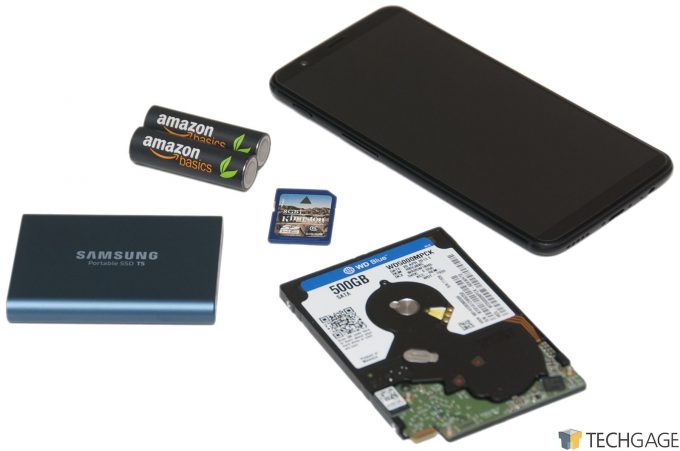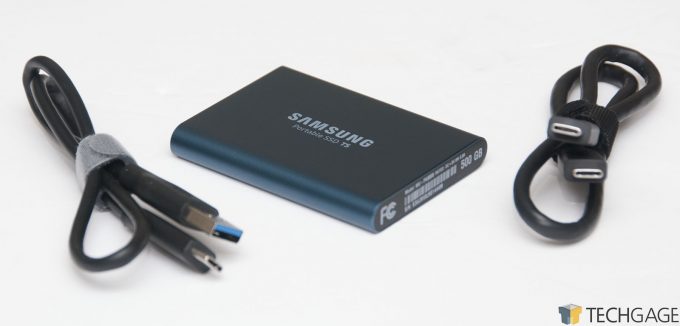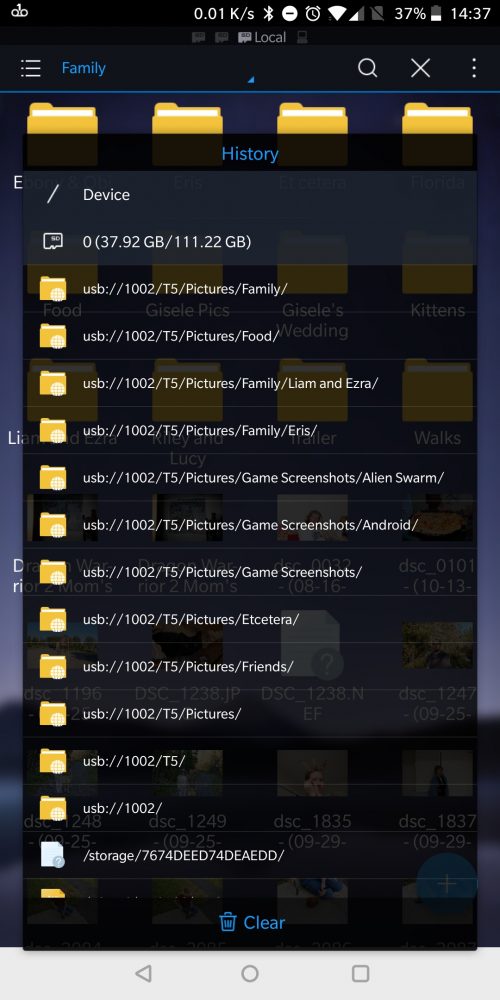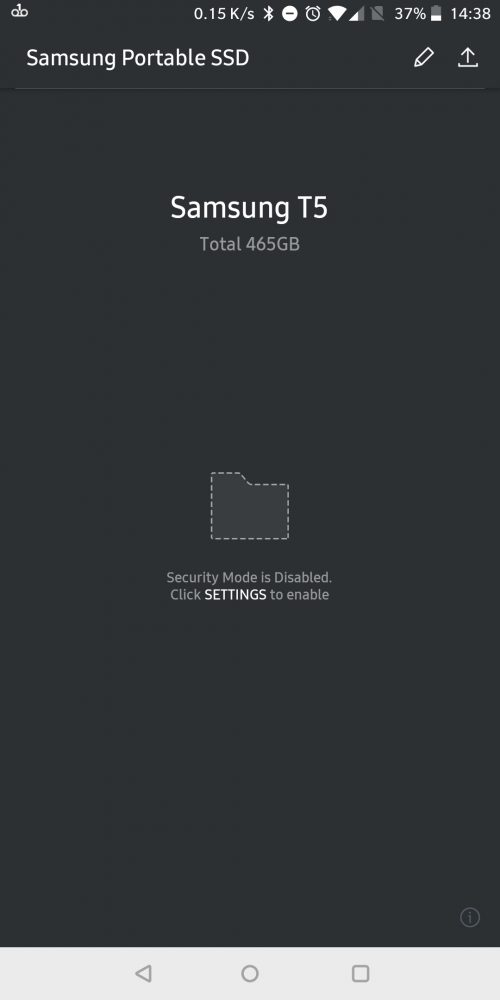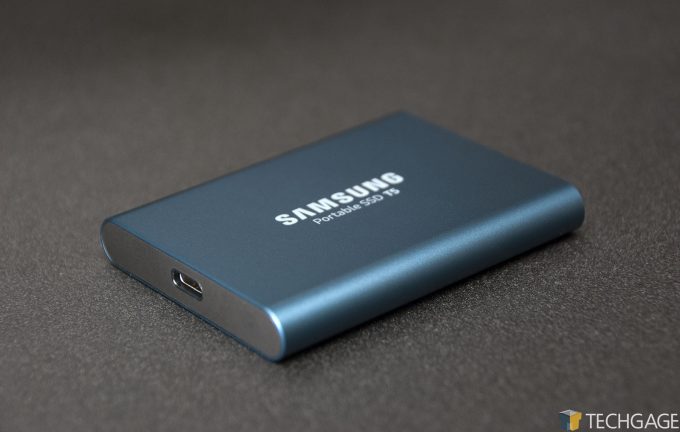- Qualcomm Launches Snapdragon 4 Gen 2 Mobile Platform
- AMD Launches Ryzen PRO 7000 Series Mobile & Desktop Platform
- Intel Launches Sleek Single-Slot Arc Pro A60 Workstation Graphics Card
- NVIDIA Announces Latest Ada Lovelace Additions: GeForce RTX 4060 Ti & RTX 4060
- Maxon Redshift With AMD Radeon GPU Rendering Support Now Available
A Look At Samsung’s Ultra Small, Ultra Fast & Ultra Portable SSD T5 500GB

When you need ultra-fast storage on-the-go, it’s pretty hard to go wrong with a drive like Samsung’s T5. It’s not the least-expensive offering out there, but it has a lot of good going for it. It’s small, looks good, has a shock-resistant design, and best of all, sports internal SSD-like speeds over USB 3.1 gen2.
Despite their performance capabilities, portable SSDs are not complicated products. They need to have good NAND, housing that can withstand the occasional shock, and generally be as reliable as possible. The audience Samsung would cater its T5 SSDs to are those who want a lot of super-fast storage on-the-go in a great form-factor. The fact that the drive looks good may help, too.
Speaking of looks, the T5 isn’t flashy, but that’s a good thing. It has rounded corners at the top and bottom, which makes it nice to hold in your hand – not that it will take up much space there. The drive is exclusively USB Type-C, although two cables are included with Type-A or Type-C opposite ends. Because the drive is so low-power, the USB connection provides more than enough juice for this drive.
On the box, Samsung points to support for Windows, Mac, and Android. Interestingly, Linux has been given the shaft here, but this is ultimately a standard SSD – it’s going to work as long as the OS supports the drive’s file system. Samsung ships its T5 with exFAT, allowing it to be as cross-platform as possible out-of-the-box. You can format it to any other file system should you want to; you just need to bear in mind that you may lose your cross-platform freedoms.
Speaking of those freedoms, if you enable the security feature built into the T5, you may run into issues trying to access the data on OSes which Samsung doesn’t support. Thankfully, this issue will be quite rare, but it’s worth mentioning nonetheless. For mobile, Samsung offers an app for Android on the Play Store, while the Windows and macOS versions are found on the drive itself. Should you lose those files, you can snag them again from the official product page.
The shot below should help give some perspective as to the size of the T5. The AA batteries in the shot are a bit thicker than the drive, so all things considered, this drive is pretty modest in size. Something the picture can’t give justice to is the fact that the T5 is super-light. Those two batteries in the picture weigh 60g, whereas the Samsung drive is 50g. You won’t even notice it in your pocket – unless of course the cable is also in there, poking you in the leg.
Speaking of cables, I mentioned before that this drive includes two: one is for those using a standard USB Type-A connection, while the other lets those with Type-C notebooks and phones use a cable you can’t plug in backwards, on either end.
When plugged into a phone, you should be notified that OTG storage is connected. Oddly, I didn’t have any such notification on the OnePlus 5T, but I did on a OnePlus 3. The reason for the issue on the former is that an OTG option needed to be explicitly enabled inside of the system settings; so, if you run into the same issue, where your phone acts like you didn’t just plug something in, you may need to scour for that OTG toggle.
The software solution provided with this drive is extremely simple overall; its only use is to enable security. So, to be clear, unless you plan to use encryption, you don’t need to install the software. For a drive like this, a robust software package isn’t really needed, but I would have liked to have seen an option to format the drive from inside of this tool, and see its SMART data. Alas, it’s not the end of the world.
I might be alone in this, but I assumed that Samsung’s Android app would allow you to… you know, explore the storage, but not so. Instead, once the drive is properly detected by Android, you’ll be able to access it through any file manager app that supports USB storage. Above, ES File Explorer is shown, but the default file manager works just fine, as well.
In trying to get the T5 to work on my phone, I did have to jump through a couple of hoops, because I had the bright idea to reformat the drive using different file systems before I tested out the mobile functionality. As it happens, I simply had the drive formatted incorrectly, but after plugging it into my phone with no file system at all, I got a prompt to format it, which solved all of my issues.
I admittedly didn’t feel incredibly compelled to crack the T5 open, but under the hood is Samsung’s 64-layer V-NAND, which, as you’d probably guess, is 3-bits-per-cell (TLC). It’s really quite cutting-edge NAND, and while it’s not MLC or SLC, the T5 almost certainly has way more life than you’ll actually need out of it. Unless you’re using an SSD for server use, you really don’t need to worry about SSD durability much nowadays, which would be doubly true for external storage that’s written to far less frequently.
I think that about covers all of the important details, so now it’s time to get into a look at performance. Because I don’t have a slew (or even two) external drives tested, I am not going to be comparing the T5 to another. Instead, I’m going to present standalone benchmarks that will still get the point across. The PC tested on uses ASUS’ STRIX X299-E GAMING motherboard. The drive was plugged straight into the Type-C 3.1 gen2 port using the included C-to-C cable.
The first test I ran after plugging the drive in for the first time was CrystalDiskMark. This gives us a general impression of maximum performance that can be expected. As the shot shows, Samsung’s promise of “up to” 540MB/s read has been exceeded, with 4K writes hitting ~320MB/s, which is roughly what you’ll see in the real-world (the same is generally true about internal SATA 6Gbps SSDs).
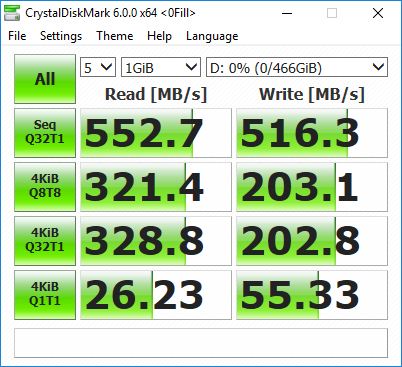
HD Tune helps us look at the drive from another perspective; namely, how many operations per second it can handle. For perspective, bear in mind that most mechanical hard drives wouldn’t surpass 100 IOPS in most of these tests, whereas the T5 hits nearly 10,000 in both read and write 4K tests.
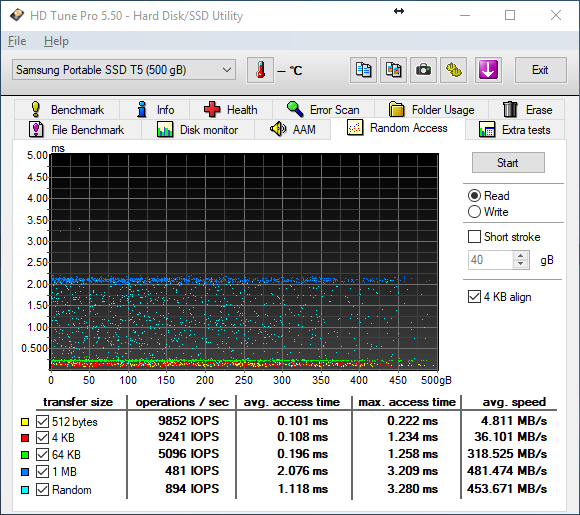
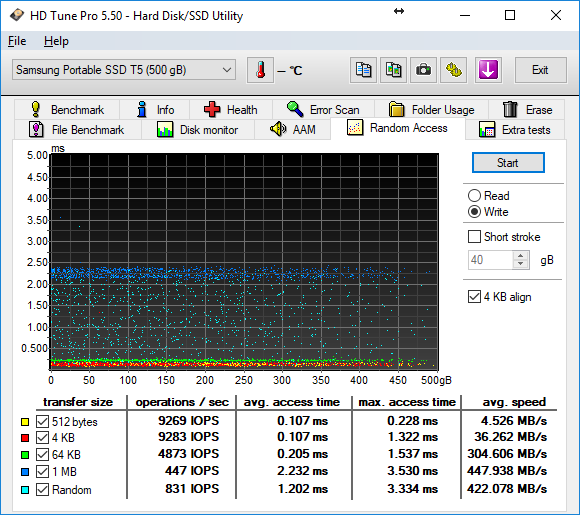
“You got any of those real-world results, homie?” I thought you’d never ask. Because the PC I tested this drive on had 64GB of memory, I primarily tested with a 96GB folder that included 10 or so files:
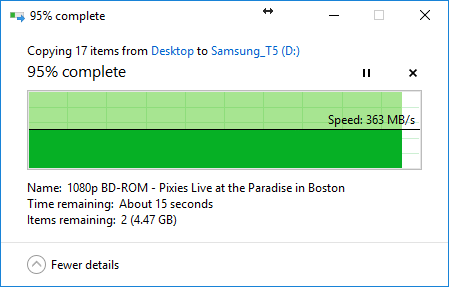
Real-world Samsung T5 Write Tests
- 96GB Folder Write: 4m 38s (~345MB/s)
- 5.16GB 500 Files Write: 20s (~260MB/s)
- 4K Iometer 100% Drive Fill: 27m 58s (~320MB/s)
You might notice that the 363MB/s in the screenshot above doesn’t match the 345MB/s reported here, but that’s because it was a later casual retest that I didn’t time. In that way, the performance got a little bit better, but caching can’t play much of a role given the huge transfer size.
The reason I did the Iometer fill test listed above is because I wanted to thrash the drive a bit, or “dirty” it up, if you will. I wanted to see what kind of performance degradations would occur after the drive got some use, and in total, I filled the drive completely twice, and copied back and forth the project files to get it nice and broken in.
That’s a lot of preamble to say something simple: I didn’t notice an ounce of difference in the performance after battering the drive with lots of data. I could retest the drive after a few months and see how the performance is impacted, but for a drive of this nature, I wouldn’t expect much long-term degradation at all – even if you’re to use it as a projects drive (video, photos, etc).
Final Thoughts
I mentioned in the intro that for the most part, portable SSDs are simple products. And really, they are. But despite that, they’re still a valuable part of your mobile toolbox. It’s nice to be able to plug in a fat storage drive that delivers way better performance than mechanical storage. And, unlike mechanical storage, you don’t need to worry about being rough with a drive like the T5.
What I personally plan to use this drive for is Acronis backup images. Restoring images to our test PCs here is like second nature at this point, but for storage reasons, I’ve stuck to mechanical (network) storage to get a system up and running. With a drive like the T5, the backups will restore much quicker than before, and with 500GB on tap, I don’t have to worry about running out of space for that need.
I explored the potential to use the T5 as a boot drive, and it’s definitely possible, but it’ll require a bit of effort. I hoped to create an Acronis boot drive with the T5, but that wasn’t possible as neither Acronis or solutions like Rufus were interested in writing to such a large drive. In Windows, the T5 is treated the same as an internal disk, so you need to get crafty.
I’ve heard that it’s possible to create a boot drive with Acronis by capturing an Acronis bootable image (yo dawg) from a flash drive, and then restore it to the large drive. In my case, I sucked it up and just stuck a Windows 10 install on there, although once again, because the T5 is treated as internal, I couldn’t use Microsoft’s own tool to get the job done. Instead, I used ‘diskpart’ (detailed here) to manually prepare the drive, and it worked beautifully after that.
To be fair, that kind of use is not really Samsung’s target, but it is useful to know that you can use it as a boot drive if you want to – even if it’s just to leave a Windows 10 install on there in case something goes awry on one of your machines (you don’t want to be caught without proper media!).
Overall, I’ve been very pleased with this drive, though I admit I’ve spent way more time benchmarking it than actually using it. That’ll change now, and since I didn’t see much of a performance difference after “dirtying” the drive, it may be useful to revisit performance in a few months and see how things have changed.
For pricing, every density is available at Amazon, with the 500GB model reviewed selling for $170. A 250GB model sits at $110. Unfortunately, you don’t save money per GB by going higher; the 1TB is sold for $350, while the 2TB is available for $740. Worth noting is that the 1TB and 2TB models are no larger (physically) than the 500GB model. That’s a lot of super-fast storage in your pocket – though, in reality, you could probably fit 5 of these things in your pocket before you’d start to notice them.
Support our efforts! With ad revenue at an all-time low for written websites, we're relying more than ever on reader support to help us continue putting so much effort into this type of content. You can support us by becoming a Patron, or by using our Amazon shopping affiliate links listed through our articles. Thanks for your support!





